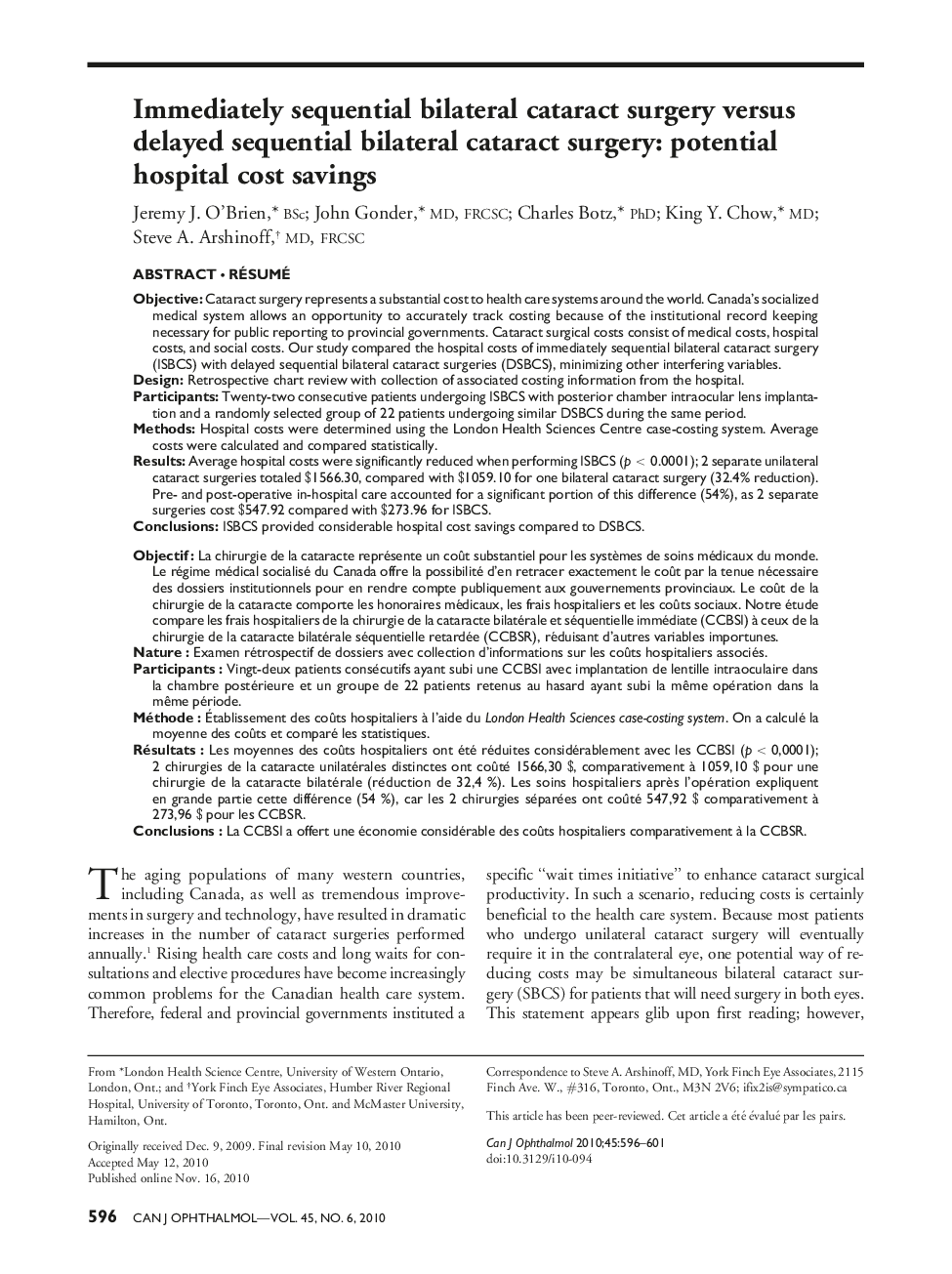| Article ID | Journal | Published Year | Pages | File Type |
|---|---|---|---|---|
| 4010122 | Canadian Journal of Ophthalmology / Journal Canadien d'Ophtalmologie | 2010 | 6 Pages |
Objective: Cataract surgery represents a substantial cost to health care systems around the world. Canada's socialized medical system allows an opportunity to accurately track costing because of the institutional record keeping necessary for public reporting to provincial governments. Cataract surgical costs consist of medical costs, hospital costs, and social costs. Our study compared the hospital costs of immediately sequential bilateral cataract surgery (ISBCS) with delayed sequential bilateral cataract surgeries (DSBCS), minimizing other interfering variables.Design: Retrospective chart review with collection of associated costing information from the hospital.Participants: Twenty-two consecutive patients undergoing ISBCS with posterior chamber intraocular lens implantation and a randomly selected group of 22 patients undergoing similar DSBCS during the same period.Methods: Hospital costs were determined using the London Health Sciences Centre case-costing system. Average costs were calculated and compared statistically.Results: Average hospital costs were significantly reduced when performing ISBCS (p < 0.0001); 2 separate unilateral cataract surgeries totaled $ 1566.30, compared with $ 1059.10 for one bilateral cataract surgery (32.4% reduction). Pre- and post-operative in-hospital care accounted for a significant portion of this difference (54%), as 2 separate surgeries cost $547.92 compared with $273.96 for ISBCS.Conclusions: ISBCS provided considerable hospital cost savings compared to DSBCS.
RésuméObjectif: La chirurgie de la cataracte représente un coût substantiel pour les systèmes de soins médicaux du monde. Le régime médical socialisé du Canada offre la possibilité d’en retracer exactement le coût par la tenue nécessaire des dossiers institutionnels pour en rendre compte publiquement aux gouvernements provinciaux. Le coût de la chirurgie de la cataracte comporte les honoraires médicaux, les frais hospitaliers et les coûts sociaux. Notreétude compare les frais hospitaliers de la chirurgie de la cataracte bilatérale et séquentielle immédiate (CCBSI) à ceux de la chirurgie de la cataracte bilatérale séquentielle retardée (CCBSR), réduisant d’autres variables importunes.Nature: Examen rétrospectif de dossiers avec collection d’informations sur les coûts hospitaliers associés.Participants: Vingt-deux patients consécutifs ayant subi une CCBSI avec implantation de lentille intraoculaire dans la chambre postérieure et un groupe de 22 patients retenus au hasard ayant subi la même opération dans la même période.Methode: Établissement des coûts hospitaliers à l’aide du London Health Sciences case-costing system. On a calculéla moyenne des coûts et comparé les statistiques.Résultats: Les moyennes des coûts hospitaliers ont été réduites considérablement avec les CCBSI (p < 0,0001); 2 chirurgies de la cataracte unilatérales distinctes ont coûté 1566,30 $, comparativement à 1059,10 $ pour une chirurgie de la cataracte bilatérale (réduction de 32,4 %). Les soins hospitaliers après l’operation expliquent en grande partie cette différence (54 %), car les 2 chirurgies séparées ont coûté 547,92 $ comparativement à 273,96 $ pour les CCBSR.Conclusions: La CCBSI a offert une économie considérable des coûts hospitaliers comparativement à la CCBSR.
